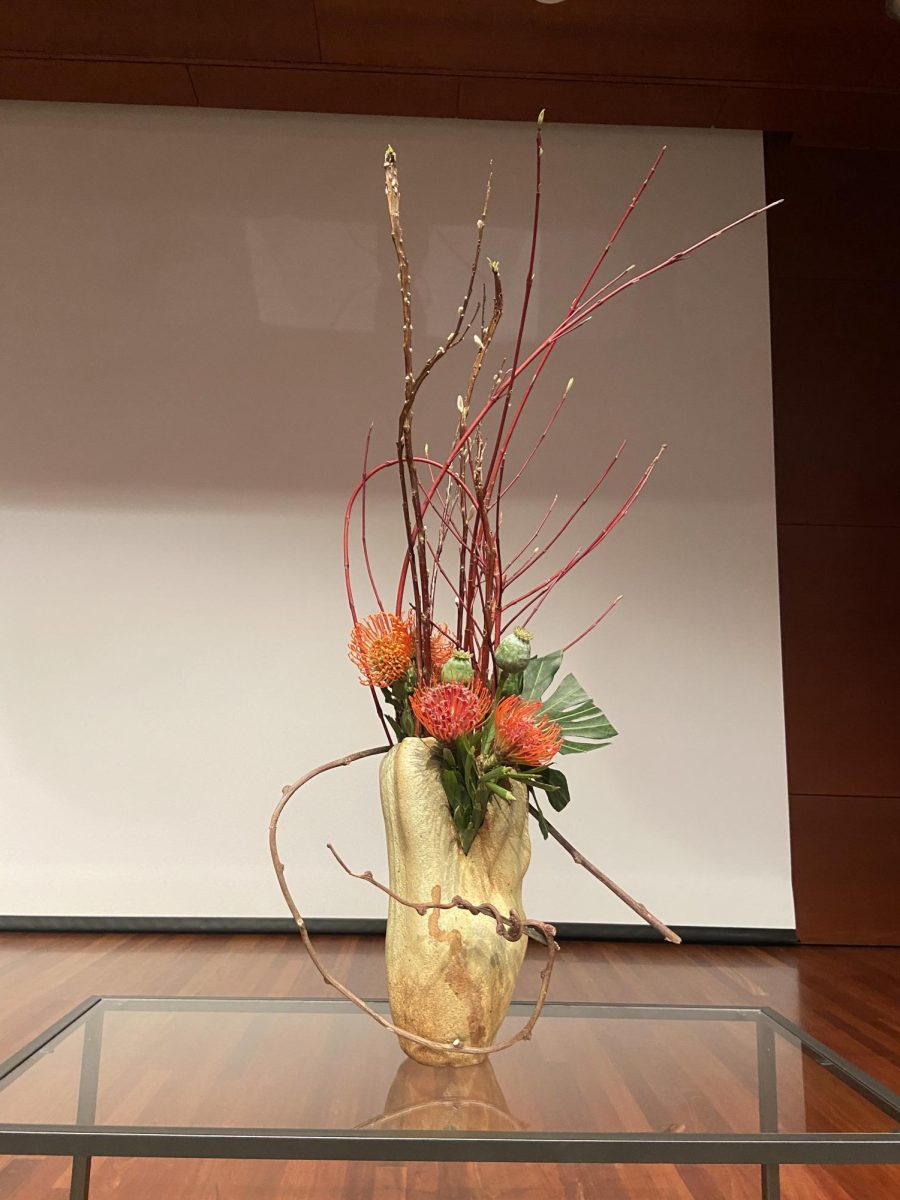The Utah Museum of Fine Arts celebrated ikebana, the Japanese art of flower arrangement, during an event on May 2. UMFA hosted Kimi Hill to share the story of her grandmother, the issei ikebana sensei Haruko Obata. The event also included a performance by Shirley Kazuyo Muramoto and Brian Mitsuhiro Wong using traditional Japanese instruments, the koto and shakuhachi.
“Kimi Hill will delve into Haruko’s fascinating life story, which is drawn from a comprehensive 20-hour oral history recording with her grandmother,” said Derrek Wall, director of programs at UMFA, while introducing Hill. “That’s so hardcore.”
Hill began with a brief introduction of ikebana.
“Ikebana is the art of Japanese flower arrangement,” Hill explained. “This art form cultivates an awareness of plants and develops for the practitioner such a very acute appreciation of the four seasons.”
Obata grew up in Japan until she was 18 when she moved to San Francisco alone. She went to a dressmaking school while learning English until she met her husband, Chiura Obata, two years later and immediately started a family with him.
Japanese American Internment Camps
Both Obatas were artists and moved several times before Pearl Harbor was bombed in 1941. The Obata family was quickly ordered to move to an internment camp in Topaz, UT. The camp was half-finished, Hill described, and was subject to frequent dust storms. Chiura Obata made several paintings and sketches during his family’s time at this camp, which Hill shared. One picture showed dust sweeping into the Obata’s room through cracks in the windowsill. To keep some sense of normalcy, the family had an ikebana arrangement on a table that Chiura Obata included in his sketch.
While at this camp, Chiura Obata opened an art school, and Haruko Obata taught ikebana here.
“They were using anything they could find there, they were total recyclers,” Hill said. “Wood, scraps, lumber or the indigenous plants or the firewood that was brought in and they would create vases.”
The Obata family only spent one year in internment camps, while many Japanese-Americans had to spend three years living in them. The government made occupants at these camps fill out loyalty questionnaires, which led to tension within the camps. Chiura Obata was assaulted in the camp as a result of these questionnaires, and after he recovered his family was released out of concern for his safety.
“While he was recuperating in the hospital, this incident happened where a man about his age, just a few years older, was shot and killed for walking too close to the barbed wire fence,” that surrounded the camp, Hill said, displaying a drawing Chiura Obata made of the incident. “The guns were pointed inward, they were not there to protect the Japanese community.”
The family lived in St. Louis after their release and remained there until the end of the war. Then they returned to the Bay Area where they had established themselves before being detained. Chiura Obata returned to teaching at Berkeley University, where he was employed before the war started, and Haruko Obata continued her work in ikebana.
Balance and Imbalance in Ikebana
“As Haruko said, ‘We hope that in creating your own arrangements, you will find the philosophy of natural beauty, which is life,’” Hill quoted. After Hill’s presentation finished, Keiko Kubo from the Sogetsu School of Ikebana elaborated on the art of Ikebana and discussed an arrangement she’d made for the event.
“Beauty comes out of tension,” Kubo said while describing how she’d bent dogwood branches to curve in her arrangement. Some of the branches snapped back into place while others remained in the curved position she had set them in. It’s finding that spot between balance and imbalance, Kubo described. Life feels like that.
“Japanese aesthetic is not symmetrical,” Hill described at the start of her presentation. “There’s this triangle as a sense of balance.” Hill pointed to how many ikebana arrangements form a triangle of sorts in their form.
After the presentation, attendees made their way to UMFA’s Great Hall, where Muramoto and Wong played traditional and more modern music on instruments that Japanese Americans had played in internment camps years ago. Wong walked around the crowd with a photo of the instruments being played while Muramoto described the instruments’ history.
Muramoto described how after detainees were released, many abandoned their Japanese traditions to assimilate into American culture. They wanted to become “110% American,” as Muramoto described.
The duo then played several pieces that rang through the hall before the event finished. Attendees were invited to stroll through UMFA’s current exhibit, “Pictures of Belonging,” which features the work of three prominent Japanese-American female artists.



